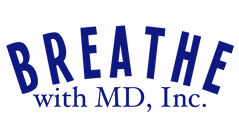
Fact 1: It’s a fact that for those living with weakened breathing muscles, mechanical ventilation saves lives. Individuals with Neuromuscular Disease are living longer and thriving because of it. Learn more at https://breathewithmd.org/assisted-ventilation.html.
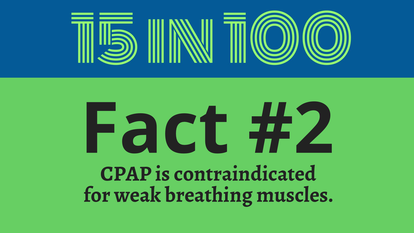
Fact 2: It’s a fact that CPAP is not recommended for those with weakened breathing muscles. CPAP offers one single positive pressure of air. In order to fill the lungs with enough air, that pressure will be too strong to exhale against and will not assist with ventilation. If your breathing muscles are weakened, you need bi-level ventilation (BPAP/BiPAP), NOT CPAP. Bi-level ventilation offers two different positive pressures of air, one stronger pressure to inhale and a second much more reduced pressure to exhale against. It will assist in moving air into and out of the lungs.
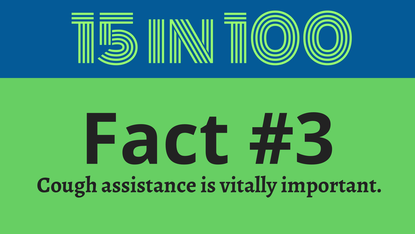
Fact 3: As respiratory muscles weaken, cough function becomes impaired with cough becoming weaker and/or ineffective at clearing airway secretions. The longer the secretions stay in the airways, the more likely they are to cause bacteria to multiply, increasing the risk for respiratory infection and/or pneumonia.
Mechanical cough assistance devices can expand the lungs, mimic a stronger, more effective cough, propel secretions up and out of the lungs, and prevent or resolve pneumonia. For more about Cough Assistance, see https://breathewithmd.org/cough.html/.
Mechanical cough assistance devices can expand the lungs, mimic a stronger, more effective cough, propel secretions up and out of the lungs, and prevent or resolve pneumonia. For more about Cough Assistance, see https://breathewithmd.org/cough.html/.
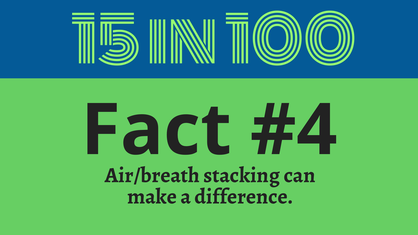
Fact 4: It’s a fact that air/breath stacking (also known as lung volume recruitment) can make a difference. “…lung volume recruitment aims to avert functional decline as a result of atelectasis and chest wall contractures.” https://downloads.hindawi.com/journals/pm/2019/2734054.pdf
For more detail on air/breath stacking, check out the recording of our mentoring program’s session on it at https://youtu.be/hJMAeGlPmVY.
For more detail on air/breath stacking, check out the recording of our mentoring program’s session on it at https://youtu.be/hJMAeGlPmVY.
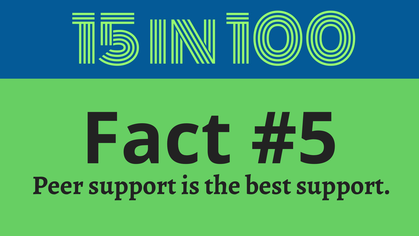
Fact 5: It’s a fact that peer support is the best support. If you are living with a Neuromuscular Disease (NMD) or have a close family member who does, don't forget about our Breathe with MD Support Group as a resource for neuromuscular breathing weakness questions, tips, suggestions, and even articles or other helpful files you can view and/or print directly from the group. The group began at the end of 2014 and has nearly 1,800 members located all over the world with an average of 40-50 new posts per month that are specific to breathing muscle weakness. We take the group seriously and know that some of the discussions there have been life-saving. Join today at https://www.facebook.com/groups/BreathewithMDSupportGroup/. Please make sure you answer the required membership questions.
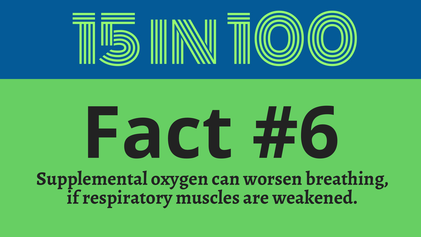
Fact 6: It’s a fact that unventilated supplemental oxygen, oxygen not worn while using mechanical breathing assistance, can worsen breathing if the individual’s respiratory muscles are weakened. Learn more about this at https://breathewithmd.org/oxygen-caution.html.

Fact 7: It’s a fact that an ABG (Arterial Blood Gas) is not the only way to check Carbon Dioxide (CO2) level to assess for hypercapnia, an elevated level of CO2 in the lungs and blood. Reliable, painless alternatives exist, including the use of a transcutaneous device that measures CO2 level through the skin with a sensor and a capnograph or capnography device that measures “end-tidal” CO2 from one’s exhaled breath. Check with your neuromuscular breathing specialist about these options to determine if they might be available to you.
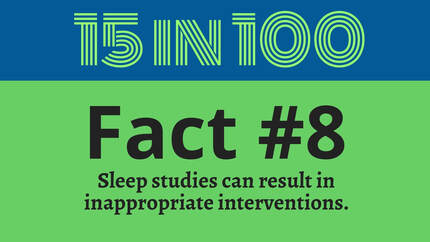
Fact 8: Sleep studies for those with Neuromuscular Disease (NMD) commonly attribute apneas (temporarily stopping breathing in sleep) and hypopneas (overly shallow breathing or abnormally low respiratory rate) only to obstructive and central apnea events instead of inspiratory muscle dysfunction and reduced respiratory muscle effort and weakness. This often leads to incorrect equipment such as CPAP being prescribed. To prevent this, ensure that your sleep study has been ordered by a neuromuscular pulmonary specialist and includes monitoring of both Oxygen saturation and Carbon Dioxide level (commonly through capnography or transcutaneous monitoring through sensors).
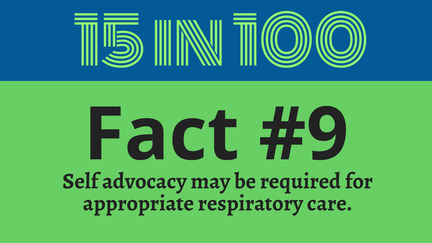
Fact 9: Too often, individuals living with Neuromuscular Disease (NMD) find themselves under the care of a clinician who wants to treat their weakened breathing muscles as if they have a lung disease and/or prescribe inappropriate inventions such as CPAP and/or unventilated supplemental oxygen. These do not assist with weak effort to breathe and hypoventilation (under ventilation) as mechanical/assisted ventilation does. This means the individual must self-advocate (speak up) to get the appropriate care. Breathe with MD, Inc. helps educate patients so that they are empowered and armed with the knowledge to successfully do so.
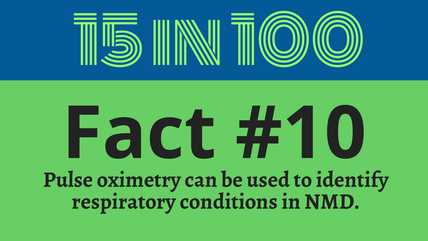
Fact 10: It's a fact that pulse oximetry can be used as a tool to monitor one's self or a loved one with Neuromuscular Disease and can help to determine if a respiratory problem is present.
"Oximeters monitor the oxygen saturation (O2 sat) of hemoglobin in the blood. Normal O2 sat is 95% or greater. Provided that supplemental oxygen administration is avoided, oximetry provides very useful information. Anytime the O2 sat decreases below 95%, one of following three respiratory conditions are present.
Lung underventilation
Airway congestion
Lung disease..."
See more details at https://www.breathenvs.com/basic-info-and-critical-concepts under the heading, "Oximetry Feedback Protocol."
"Oximeters monitor the oxygen saturation (O2 sat) of hemoglobin in the blood. Normal O2 sat is 95% or greater. Provided that supplemental oxygen administration is avoided, oximetry provides very useful information. Anytime the O2 sat decreases below 95%, one of following three respiratory conditions are present.
Lung underventilation
Airway congestion
Lung disease..."
See more details at https://www.breathenvs.com/basic-info-and-critical-concepts under the heading, "Oximetry Feedback Protocol."
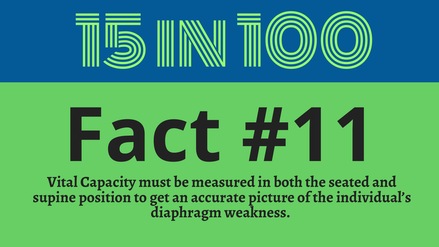
Fact 11: It is a fact that most individuals with Neuromuscular Disease (NMD) will show different Vital Capacity when seated versus when reclined.
“A sitting-supine difference of greater than 7% is abnormal. Differences greater than 30% (supine VC lower), which are caused by diaphragm weakness, usually cause “orthopnea” or inability to breathe when lying flat and indicate the need to introduce sleep NVS to breathe when reclining.”
Note: VC is Vital Capacity. NVS is Noninvasive Ventilatory Support.
Reference: https://www.breathenvs.com/e-m-older-children-and-adults
“A sitting-supine difference of greater than 7% is abnormal. Differences greater than 30% (supine VC lower), which are caused by diaphragm weakness, usually cause “orthopnea” or inability to breathe when lying flat and indicate the need to introduce sleep NVS to breathe when reclining.”
Note: VC is Vital Capacity. NVS is Noninvasive Ventilatory Support.
Reference: https://www.breathenvs.com/e-m-older-children-and-adults
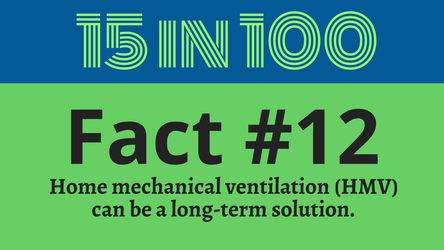
Fact 12: It is a fact that home mechanical ventilation (HMV) can be a long-term solution. Too many assume that starting HMV signals end of life. The majority of individuals living with Neuromuscular Disease (NMD) find an improved quality of life and extend their years of life because of this intervention. “Home mechanical ventilation (HMV) is an effective long-term treatment for chronic hypercapnic respiratory failure. In addition to the established practice of providing HMV for the treatment of chronic ventilatory failure in slowly progressive neuromuscular and chest wall disease, there is accumulating evidence for improvement of quality of life and prolongation of survival by HMV in highly prevalent diseases like chronic obstructive pulmonary disease and ever-increasing obesity hypoventilation syndrome as well as rapidly progressive neuromuscular disease. The key concepts for successful HMV are an experienced team selecting the right patients, timely initiation of adequate ventilation via an appropriate interface, and monitoring effectiveness during regular long-term follow-up. Coaching of patients with chronic respiratory failure on long-term HMV within a dedicated service and collaborations with community services for home care are essential.” Learn more at https://www.karger.com/Article/Pdf/499316.
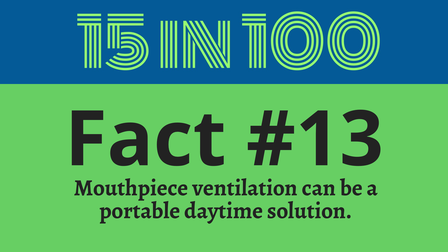
Fact 13: It’s a fact that mouthpiece ventilation can be a portable daytime solution, freeing one up from mask usage and also allowing noninvasive ventilation to be used continuously, up to 24 hours a day.
Additional information:
Dr. John R. Bach talks about use of Mouthpiece Ventilation for those who need daytime mechanical ventilation. Watch this short video to learn more about this non-invasive, wheelchair-portable option for some individuals living with Neuromuscular breathing weakness. See https://www.youtube.com/watch?v=OX4LTaELoPs.
See our founder’s “Ask Andrea” personal perspective piece about mouthpiece ventilation use at https://breathewithmd.org/ask-andrea/when-to-start-mouthpiece-ventilation?fbclid=IwAR0rgi8VB4U87_pjUuMhiPyV-oY-UYJb9nkuBfF63s40fPnJArJWX8_aLz4.
Additional information:
Dr. John R. Bach talks about use of Mouthpiece Ventilation for those who need daytime mechanical ventilation. Watch this short video to learn more about this non-invasive, wheelchair-portable option for some individuals living with Neuromuscular breathing weakness. See https://www.youtube.com/watch?v=OX4LTaELoPs.
See our founder’s “Ask Andrea” personal perspective piece about mouthpiece ventilation use at https://breathewithmd.org/ask-andrea/when-to-start-mouthpiece-ventilation?fbclid=IwAR0rgi8VB4U87_pjUuMhiPyV-oY-UYJb9nkuBfF63s40fPnJArJWX8_aLz4.
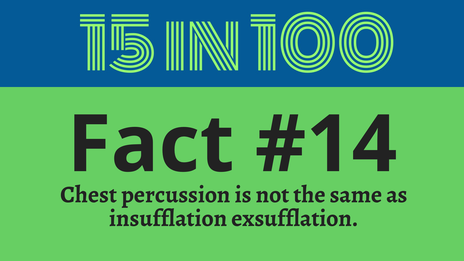
Fact 14: It’s a fact that chest percussion, often referred to as “the shaky vest,” is not the same as an insufflation exsufflation device such as the CoughAssist. Chest percussion alone won’t help to augment (strengthen) a cough.
That being said, many with Neuromuscular Disease (NMD) do see benefits from use of a chest percussion device before doing their CoughAssist therapy. We hear that some find chest percussion loosens and helps to move secretions and/or may allow the individual to need fewer repetitions with CoughAssist therapy. Others find they can successfully clear their airways with chest percussion in conjunction with a suction device.
The bottom line: It’s the CoughAsisst or similar insufflation exsufflation devices that provide a larger positive pressure breath than one can take on their own and reverses to a negative pressure breath to simulate a real cough and move secretions (mucus) up and out of the airways with typically much less effort for the individual with NMD. CoughAsisst is the only device known to pull secretions from deep areas within the lung, reducing respiratory infection severity and preventing escalation to pneumonia.
That being said, many with Neuromuscular Disease (NMD) do see benefits from use of a chest percussion device before doing their CoughAssist therapy. We hear that some find chest percussion loosens and helps to move secretions and/or may allow the individual to need fewer repetitions with CoughAssist therapy. Others find they can successfully clear their airways with chest percussion in conjunction with a suction device.
The bottom line: It’s the CoughAsisst or similar insufflation exsufflation devices that provide a larger positive pressure breath than one can take on their own and reverses to a negative pressure breath to simulate a real cough and move secretions (mucus) up and out of the airways with typically much less effort for the individual with NMD. CoughAsisst is the only device known to pull secretions from deep areas within the lung, reducing respiratory infection severity and preventing escalation to pneumonia.

Fact 15: Possible early symptoms of neuromuscular breathing weakness can include non-restful sleep, frequent awakenings, morning headaches, and anxiety and/or difficulty breathing while lying flat, just to name a few, and may not be experienced every day and often are mistaken to have causes other than breathing muscle weakness. This is why it is common to go months or years with undiagnosed breathing muscle weakness.
If you have any form of neuromuscular disease, you should see a neuromuscular breathing specialist for evaluation, attend recommended check-ups, and use any appropriate interventions to support coughing and breathing weakness. Are you struggling to find a clinician in your area? Perhaps we can assist; reach out to us today!
If you have any form of neuromuscular disease, you should see a neuromuscular breathing specialist for evaluation, attend recommended check-ups, and use any appropriate interventions to support coughing and breathing weakness. Are you struggling to find a clinician in your area? Perhaps we can assist; reach out to us today!
